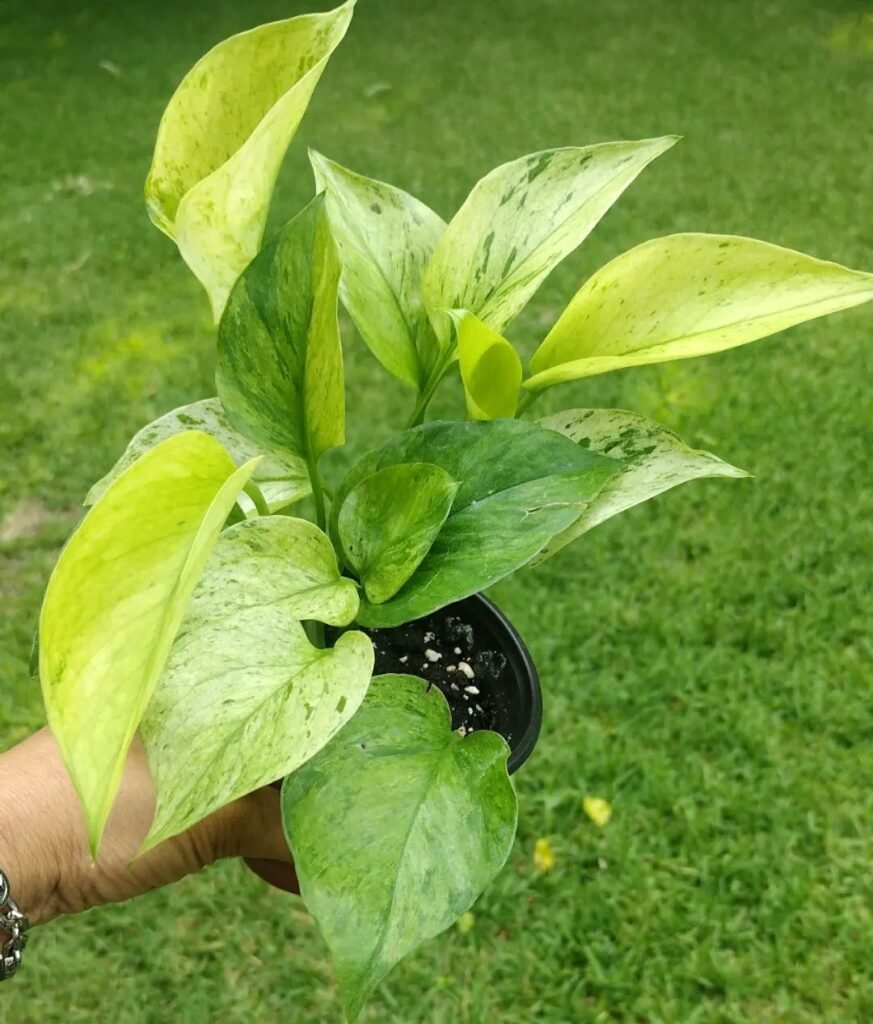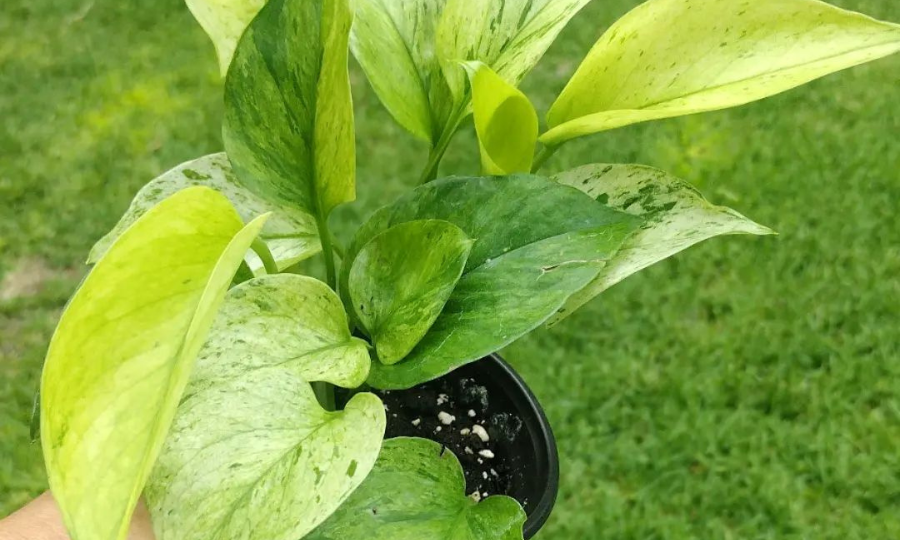Discover essential care tips for Jessenia Pothos and ensure your indoor plant thrives. Learn about optimal watering, lighting, and maintenance practices to keep your Jessenia Pothos healthy and vibrant.
Are you looking for a beautiful, easy-to-care-for houseplant that can brighten up any room? Look no further than the Jessenia Pothos! This stunning plant, with its heart-shaped leaves splashed with golden variegation, is not only a feast for the eyes but also a breeze to maintain. Whether you’re a seasoned plant parent or just starting your green journey, this comprehensive guide will help you keep your Jessenia Pothos happy and thriving.
Here’s an information chart for Jessenia Pothos:
| Aspect | Details |
|---|---|
| Botanical Name | Scindapsus pictus ‘Jessenia’ |
| Common Name | Jessenia Pothos |
| Plant Family | Araceae (Arum family) |
| Hardiness Zone | Typically zones 10-12; often grown indoors |
| Sun Exposure | Indirect sunlight to partial shade |
| Soil Type | Well-draining potting mix |
| Watering | Moderate; allow top inch of soil to dry between waterings |
| Growth Habit | Vine-like, climbing |
| Height/Spread | Up to 6 feet (1.8 meters) in height, spreads indefinitely |
| Special Features | Variegated leaves with silver and green patterns, air-purifying |
What is Jessenia Pothos?

Let’s start with the basics. Jessenia Pothos, scientifically known as Epipremnum aureum ‘Jessenia’, is a variegated cultivar of the popular golden pothos. It’s part of the Araceae family, which includes many beloved houseplants. The Jessenia Pothos is known for its unique variegation pattern – a mix of light green, dark green, and golden yellow splashes across its leaves.
According to the University of Florida’s IFAS Extension, pothos plants, including the Jessenia variety, are among the easiest houseplants to grow. They’re perfect for beginners and can tolerate a wide range of indoor conditions.
Why Choose Jessenia Pothos?
- Easy to Care For: Even if you don’t have a green thumb, you can keep a Jessenia Pothos alive and thriving.
- Air-Purifying: Like other pothos varieties, Jessenia can help clean indoor air.
- Versatile: It can be grown in hanging baskets, trained up a trellis, or allowed to trail along shelves.
- Beautiful Variegation: The unique color pattern adds visual interest to any space.
Now, let’s dive into how to care for your Jessenia Pothos.
Light Requirements
Jessenia Pothos thrives in bright, indirect light. This is key to maintaining its beautiful variegation. Here’s a quick guide:
- Best: Near a north or east-facing window
- Good: A few feet away from a south or west-facing window
- Avoid: Direct sunlight, which can scorch the leaves
According to the Missouri Botanical Garden, pothos plants can tolerate low light conditions, but this may cause them to lose their variegation over time.
Watering Your Jessenia Pothos
When it comes to watering, Jessenia Pothos likes its soil to dry out slightly between waterings. Here’s a simple watering routine:
- Check the top 2 inches of soil with your finger.
- If it’s dry, it’s time to water.
- Water thoroughly until you see it draining from the bottom of the pot.
- Empty the drainage tray to prevent root rot.
The University of Maryland Extension suggests that most indoor plants, including pothos, prefer to dry slightly between waterings. This helps prevent overwatering, which is a common issue with houseplants.
Soil and Potting
Your Jessenia Pothos will thrive in well-draining, nutrient-rich soil. Here’s a simple DIY mix you can try:
- 2 parts regular potting soil
- 1 part perlite or pumice
- 1 part coconut coir or peat moss
When it comes to pots, choose one with good drainage holes. Pothos plants aren’t too picky about pot size, but they do appreciate being slightly root-bound.
The North Carolina State Extension provides excellent information on container gardening, including soil mixes and pot selection for indoor plants like Jessenia Pothos.
Humidity and Temperature
Jessenia Pothos is pretty adaptable when it comes to humidity, but it prefers levels around 50-70%. If your home is dry, especially in winter, try these tricks:
- Use a pebble tray filled with water under the pot
- Group your plants together
- Use a small humidifier near your plant
As for temperature, keep your Jessenia Pothos between 60-80°F (15-27°C). It can tolerate brief periods outside this range, but prolonged exposure to cold can damage the plant.
The University of Vermont Extension offers great insights into creating the right environment for tropical houseplants like Jessenia Pothos.
Fertilizing Your Jessenia Pothos
Feed your Jessenia Pothos during the growing season (spring and summer) with a balanced, water-soluble fertilizer. Here’s a simple feeding schedule:
- Dilute the fertilizer to half the recommended strength
- Feed once a month during spring and summer
- Reduce or stop fertilizing in fall and winter
Remember, over-fertilizing can harm your plant, so it’s better to under-fertilize than overdo it.
The Oregon State University Extension Service provides valuable information on fertilizing houseplants, including signs of over and under-fertilization.
Pruning and Cleaning
Regular pruning helps keep your Jessenia Pothos looking its best and encourages bushier growth. Here’s how:
- Use clean, sharp scissors or pruning shears
- Cut just above a leaf node (where a leaf attaches to the stem)
- Remove any yellow or damaged leaves
- Prune back long, leggy vines to promote fuller growth
Don’t forget to clean the leaves regularly with a soft, damp cloth. This helps the plant photosynthesize better and keeps pests at bay.
Propagation
One of the great things about Jessenia Pothos is how easy it is to propagate. Here’s a simple method:
- Cut a stem with 2-3 leaves just below a node
- Remove the bottom leaf, leaving the node exposed
- Place the cutting in water or moist soil
- Wait for roots to develop (this can take 2-4 weeks in water)
- Once roots are about an inch long, transfer to soil (if started in water)
The University of Florida IFAS Extension provides more detailed information on propagating pothos plants, including Jessenia Pothos.
Common Problems and Solutions
Even with the best care, you might encounter some issues. Here are some common problems and how to solve them:
- Yellow Leaves: Often a sign of overwatering. Let the soil dry out more between waterings.
- Brown Leaf Tips: Usually indicates low humidity. Increase humidity around your plant.
- Leggy Growth: Not enough light. Move your plant to a brighter spot, but avoid direct sunlight.
- Pests: Keep an eye out for mealybugs, spider mites, and scale insects. Treat with neem oil or insecticidal soap.
- Loss of Variegation: Usually due to insufficient light. Move the plant to a brighter location to maintain its beautiful coloration.
The Pennsylvania State Extension provides detailed information on diagnosing and treating common houseplant problems.
Jessenia Pothos vs. Other Pothos Varieties
While Jessenia Pothos is beautiful, it’s not the only pothos variety out there. Let’s compare it to some of its cousins:
- Golden Pothos: The classic variety with green leaves and yellow variegation.
- Marble Queen: Features heavily variegated white and green leaves.
- Neon Pothos: Has bright, lime-green leaves without variegation.
- N’Joy Pothos: Has smaller leaves with white and green variegation.
Jessenia stands out for its unique mix of light green, dark green, and golden yellow variegation.
Decorating with Jessenia Pothos
Jessenia Pothos is not just a plant; it’s a versatile decorating tool! Here are some ideas to incorporate it into your home decor:
- Hanging Baskets: Let the vines trail down for a dramatic effect.
- Bookshelf Accent: Train it to grow along your bookshelf for a natural touch.
- Living Wall: Use multiple plants to create a stunning green wall.
- Trellis Climber: Train it up a trellis for a beautiful room divider.
Remember to rotate your plant regularly to ensure even growth and prevent it from becoming lopsided.
The Smithsonian Gardens offers excellent resources on creating beautiful indoor plant displays that can be applied to showcasing your Jessenia Pothos.
Jessenia Pothos and Pet Safety
It’s important to note that like all pothos varieties, Jessenia Pothos is toxic to pets if ingested. The plant contains calcium oxalate crystals, which can cause irritation and swelling in the mouth and digestive tract of cats and dogs.
If you have pets, consider placing your Jessenia Pothos in a hanging basket or on a high shelf out of reach. Always supervise pets around houseplants and contact your veterinarian if you suspect your pet has ingested any part of the plant.
For more information on toxic plants, you can check out the ASPCA’s toxic plants list.
Environmental Benefits of Jessenia Pothos
Beyond its aesthetic appeal, Jessenia Pothos offers some great environmental benefits:
- Air Purification: NASA’s Clean Air Study found that pothos plants are excellent at removing indoor air pollutants like formaldehyde and benzene.
- Increased Humidity: Like many plants, pothos release water vapor through their leaves, which can help increase humidity in dry indoor environments.
- Stress Reduction: Studies have shown that indoor plants can help reduce stress and improve mood.
The University of Georgia Extension provides more information on the air-purifying qualities of houseplants like Jessenia Pothos.
Is Jessenia Pothos Right for You?
Before you rush out to buy a Jessenia Pothos, consider these points:
- Light Conditions: Do you have a spot with bright, indirect light?
- Care Level: While easy to care for, it does need regular attention.
- Space: Do you have room for a potentially long, trailing plant?
- Pet Considerations: Remember, it’s toxic if ingested by pets.
If you can meet these needs, a Jessenia Pothos can be a wonderful addition to your indoor garden.
Conclusion
Caring for a Jessenia Pothos might seem like a lot to remember at first, but with these tips and tricks, you’ll be well on your way to becoming a pothos expert. Remember, every plant is unique, and it might take some time to figure out exactly what your Jessenia Pothos needs in your specific environment.
Don’t be discouraged if you face some challenges along the way – that’s all part of the plant parent journey! With patience, attention, and lots of love, your Jessenia Pothos will grow into a stunning, trailing beauty that brings life and color to your space.
So, are you ready to bring home a Jessenia Pothos? With its beautiful variegation and easy-care nature, it’s sure to become a favorite in your indoor garden. Happy planting!








Leave a Reply